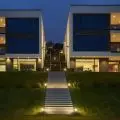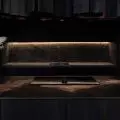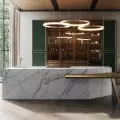What is the problem with modern barns? What is the professional responsibility of an architect in the era of climate change? How is the Miedzianka festival changing? Reporter and photographer Filip Springer talks about all this.
Wiktor Bochenek: You recently caused a Facebook storm about modern barns, which are springing up in more and more new places in our landscape. The form of modern barns does not fit into Poland's already devastated landscape?
Filip Springer: The form may fit, but this post was not about their form, but about how they treat the landscape. I have no objection to the form itself. Of course, these are buildings of different quality, designed by different architects. The way in which the landscape is being devastated with these buildings, spilling single-family housing into landscaped valuable areas, is the main problem with modern barns, not their form.
Wiktor: So the whole problem has been the same demon for years - spatial chaos, lack of planning and suburbanization?
Filip: I don't know if it's a matter of suburbanization, it's a phenomenon of urban sprawl. In this case, it's about development in any landscape, whether it's suburban, located between villages or completely undeveloped. One should be aware that we have had problems with urban planning and legislation for years. On the other hand, they, in the course of gathering momentum of the climate catastrophe, are gaining a whole new meaning. Our urban planning problems, which I described in "Bathtub with a Colonnade" in 2013, are something else in the context of how much we have learned since then about the state of the planet and the climate. The problems we have are the same, only they have turned out to be more serious.
Victor: Are we moving away a bit from the problems of the "Colonnade Bathtub"? Are there subtle rays of hope emerging?
Filip: Considering that as of recently it is possible in Poland to build a house up to 70 square meters without a building permit, we are further rather than closer to solving the problems. The only thing that is changing is that some of the purely aesthetic problems described in "Bathtub with a Colonnade," such as "signboardosis" and "reklamosis," are actually about to become irrelevant. Aesthetics in architecture will soon become completely irrelevant, as architecture faces entirely new challenges. In this sense, it would be good for buildings that meet climate challenges to have the right form, but no one will soon have the head to deal with these problems. This is the only thing that has changed, definitely for the worse.
The nice times when we could talk about the aesthetics of architecture are coming to an end.
Wiktor: So we are left with the problems of the climate catastrophe alone.
Filip: I'm not sure that the Polish architectural community is deeply convinced that this is the biggest problem to face. Instead, I am convinced that if we don't realize it, reality will do it for us quite emphatically.
Wiktor: Despite the fact that cities are overflowing and problems directly related to the climate catastrophe are piling up, more and more cities are turning to aesthetic problems. Are Sopot or Krakow introducing a fight against adversity, a misplaced proportion?
Filip: No. Let it happen, if these cities have the resources and capabilities associated with enacting these documents. But they are about to lose such opportunities as a result of climate change. I'm not urging anyone to abandon these solutions that they have been fighting for years. If something has been started, it is worth finishing it.
What I'm saying is that sooner or later cities will have to end up with aestheticization and space cleanup projects. Recently Rafal Trzaskowski announced that a new park will be built in Goldzinow - an example of aestheticizing space, not preventing climate change. At some point we will change such projects to looking for solutions to provide water and electricity to residents. I am thinking here about a decade or so.
"Bathtub with a Colonnade" lived to see another expanded edition
© Filip Springer
Victor: Another second edition of the Ecopoetics School is being launched. Why was this project created and what is most important about it?
Filip: The most important thing is that a group of people or an environment that will bring ecocritical reflection into the public debate should be created fairly efficiently. One that is able to describe the relationship between man and nature in a new way. Today we operate with an outdated culture-nature scheme, by which we exploit this nature without looking at the cost.
We want people who already know how to write to get up to speed with us with knowledge and a kind of reflection, to use the ability to write to reimagine the world and the relationship between humans and the planet. The school has school in its name, by which one might think that the main purpose is educational. On the other hand, it is an activist venture, not to say even a lobbying one. The school is supposed to bring people into the debate who will loudly articulate the issues about climate change.
Victor: We think about climate change and its catastrophic effects in a wrong way?
Filip: Of course we do. We need to realize that stopping the damage associated solely with climate change, depends on greenhouse gas emissions. For some reason, we can't imagine a world where we stop doing that. As a result, we already know that this is not a purely technological challenge, but one that is related to a certain vision of how humans use the planet and how they behave on it.
This requires thinking holistically. How we define ourselves in relation to other beings, how we define community, how we define time and our temporality, or to what extent we are part of the ecosystem. The literature can answer these questions. The tools to master climate change are on the table, but for some reason we don't pick them up off the table. It's a matter of the head, not the hands.
Victor: For many years, you have not only been documenting and describing the effects of man's actions, his impact on the environment, but also actively working to change thinking. We often fall into an almost paralyzing anxiety when thinking about climate change - should we change the way we think?
Filip: Climate depression has been described many times before, and also many researchers point out that the primary way to deal with it is to build strong communities and activism. A great many people have lived through a period called climate depression, and they indicate that getting involved in building something is the solution. In a situation of resource scarcity, neighborhood communities can be the cells most resilient to such situations.
Victor: Let's go back to the topic of architecture. You mentioned that you are not convinced that architects are aware of the challenges of climate change. Some Polish architectural firms two years ago signed the Architects Declare: Polish Architects for the Climate manifesto, in which they pledged to design more environmentally responsible.
Filip: We have to realize that the impact of architecture is about 40 percent of emissions, of which cement production alone is 11 percent. If we realize this then architecture and architects face an important question. This question is not "How to design?" but "Should we design at all?" This is also an ethical question.
I am very glad that Polish architects have set up the initiative you mention, but it is not enough. This attitude is not uniquely Polish. Today we are unable to maintain any path to neutralize climate damage without significantly reducing construction traffic.
Today it is unthinkable from the perspective of the ecological footprint to build single-family houses. In a sense, it is obscene from the perspective of investors, as well as the architects who work on it.
We need housing all the time in Poland, and today the great challenge is to build a dense city that makes the most efficient use of space, and on the other hand to make this city livable, green, blue and ventilated. Building superfluous buildings, on the other hand, does not serve our basic purposes. This is a huge challenge.
Architects will have to transform themselves from people who are competent at building so that it's comfortable for us to someone who will respond in a design way to the challenge of growing discomfort. If we realize this, some initial movement in the architectural community must be judged to be decidedly inadequate. Architects, of course, defend themselves that it's not their fault, because they are the contractors, but if that's the case, let them strike down the provision for a profession of public trust.
Wiktor: After several years , the Miedzianka festival is returning, in a slightly different form - what will this year's edition look like?
Filip: This year's edition of the Miedzianka festival is different in that instead of being in one place for three days, we will be traveling across Poland with the entire program. The program will be spread over seven different cities. We will be on the move every day with the festival. This is mainly due to the fact that Miedzianka was not equipped to receive such crowds, and also the anthropopressure and ecological footprint we had on the place was unsustainable. We wanted to preserve the intimate atmosphere of the festival. Other than that, not much is changing, we continue to be a festival about literature.
Wiktor: Thank you for the interview.
This year, the Miedzianka festival returns
© Filip Springer




















